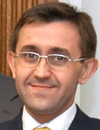08:00 | Conference Registration, Morning Coffee, and Tea in the Exhibit Hall |
09:00 | |
09:30 |  | Keynote Presentation Scaling Photochemistry Using Continuous-Flow Technology
C. Oliver Kappe, Professor and Scientific Director, Center for Continuous Flow Synthesis and Processing, University of Graz, Austria
Within the synthetic chemistry community, photochemistry has made significant recent impact, with a plethora of novel transformations reported. These take place by irradiation of: the substrate directly; an in situ-generated charge transfer complex; or a metal or organic photocatalyst. The implementation of synthetic photochemistry can already begin to meet the aims of green chemistry through two main principles: a) performing known disconnections under milder conditions, by using photons as a mild and traceless reagent to activate otherwise benign starting materials; b) enabling entirely new disconnections, which can complete target-oriented syntheses in fewer steps, for significant savings in resources, time, energy and waste.
Photochemistry in batch is generally limited by poor light penetration, therefore, scaling up to larger batch reactors is generally impractical. Performing photochemistry in continuous flow has been demonstrated as a widely suitable method to perform photochemical reactions on larger scales. , In this presentation a number of illustrative examples of flow photochemistry from our laboratories using different light sources and reactor technologies will be discussed, with special emphasis given to handling solids in flow and the synthesis of Active Pharmaceutical Ingredients (APIs). |
|
10:00 | Emulsion Polymerization in Ultrasonic Microreactors
Simon Kuhn, Professor, Department of Chemical Engineering, KU Leuven Belgium, Belgium
Polymeric dispersions have broad applications in adhesives, coatings, catalyst support, encapsulation, and drug delivery. One approach is the generation of miniemulsions (50nm<d<1000nm) and subsequent polymerization to synthesize polymer nanoparticles that can achieve the desired size and morphology for targeting a specific application. Ultrasonic microreactors have proven to be effective in the generation of miniemulsions, although with a high polydispersity (PDI > 0.3). To address this issue, an ultrasonic microreactor was developed, which enables the generation of a monodisperse miniemulsion (PDI < 0.3) to synthesize polymer nanoparticles. This ultrasonic microreactor consists of serpentine channels with a square cross-section of 1.2 mm in borosilicate glass with a piezoelectric plate transducer attached to one side. The miniemulsion created by the cavitation activity in the ultrasonic microreactor is then fed into a temperature controlled (75°C) coiled loop reactor for the continuous polymerization of monomer droplets. Specifically, we study the cross-linking polymerization of butyl methacrylate, for which the continuous phase is water with a surfactant (Lutensol AT50), and the dispersed phase consists of the monomer butyl methacrylate, the cross-linking agent ethyl glycol dimethacrylate, the costabilizer hexadecane and the thermal initiator AIBN. Preliminary results highlight the performance of the developed system. For a dispersed to continuous volumetric flow rate ratio of 1:4, residence time of 4 min at a US frequency and power of 47kHz and 15W, particles with a mean hydrodynamic diameter of 94 nm and PDI of 0.15 were obtained. The influence of the operating parameters (load power, frequency, surfactant concentration, flow rate ratio and residence time) on the size of the miniemulsion droplets and to control the final particle size will be discussed in detail. |
10:30 | Morning Coffee and Tea Break and Networking in the Exhibit Hall |
11:00 |  Impossible Flow Chemistry Examples in Multi-CSTR Cascades Impossible Flow Chemistry Examples in Multi-CSTR Cascades
Nikolay Cherkasov, Managing Director, Stoli Chem
Flow chemistry is excellent but everyone knows the limitations such as handling solids. Other limitations are implied and come from an interplay of parameters – the fluid velocity determines residence time, pressure drop, and mixing/heat transfer. CSTR cascades provide rapid mixing even at slow fluid feed rate. They could keep solids suspended and handle gas excess. We discuss examples that demonstrates the benefits of CSTRs.
|
11:30 |  Heterogeneous Catalytic Hydrogenations in Flow – Obstacles, Methods, and Scale-Up Considerations Heterogeneous Catalytic Hydrogenations in Flow – Obstacles, Methods, and Scale-Up Considerations
Joshua Trenchard, Chemical Engineer, AM Technology
Continuous flow manufacturing offers several benefits to the chemical industry such as: reducing carbon footprint by reducing process energy requirements and waste generation; re-shoring production to strengthen supply chains; and increasing existing process plant productive capacity. Across the industry, there is a high prevalence of heterogeneous catalytic hydrogenations with 10% of all chemical processes falling into this reaction category. It is therefore vital that a continuous flow solution at scale has the ability to perform such reactions in order to be industrially relevant. Solids handling in continuous flow reactors, however, poses significant challenges at low volume scales, hindering process development of heterogenous reactions in flow despite relative ease in higher throughput systems. A key parameter in slurry handling is the fluid velocity at which the slurry travels through the system. At higher throughputs when handling slurries, fluid velocities can be maintained far above sedimentation velocities whilst maintaining multiple orders of magnitude between particle size and line size. As throughput decreases, slurry and suspension dosing becomes a balancing act between sedimentation, where fluid velocity is no longer sufficient to maintain a homogenous mixture, and bridging, where particles in small bore lines accumulate into a cross-sectional layer rapidly leading to a blockage. An alternative option to continuous addition of catalyst is immobilisation within a flow reactor. This option allows the user to overcome the handling issues observed with heterogenous chemistry in flow, but presents fresh technical challenges, for example decreasing catalyst activity over time, and operational disturbances from catalyst changeover becoming increasingly complex with scale up. AM Technology has designed, developed, and tested multiphase handling solutions for both low flowrate slurry handling alongside immobilisation methods for application within the Coflore reactor range, ensuring a viable process irrespective of solids properties and throughput. Here we outline examples of both slurry feed and immobilisation in the Coflore ACR, exploring the benefits and drawbacks when applied to the behaviour of a continuous reactor. Also discussed are the consequential effects on upstream and downstream processing, equipment requirements, and unit operations. As no two slurries behave the same, and no two reactions are identical, we will discuss the importance of continuous flow equipment versatility, enabling process intensification through multiphase processing as well as process reliability through immobilisation.
|
12:00 | Automated Multi-Step Synthesis of Libraries for Drug Discovery in Flow
Javier Mazuela, Chemical Technologies Scientist, Janssen Research & Development, Spain
The development of flow platforms for automated synthesis of libraries would enable an efficient synthesis of lead molecules by rapidly exploring a wide chemical space for drug discovery. Here we describe the technologies implemented by Janssen in this field. |
12:30 | Continuous Cascade ChemoEnzymatic Reactions
Rodrigo de Souza, Associate Professor, Federal University of Rio De Janeiro, Brazil
Chemistry has over the decades been able to develop very complex transformations to produce multifunctional molecules. Despite these important advances, we are still using round bottom flasks and batch reactors to perform such transformations as 200 years ago. We are under a continuous-manufacturing transformation where technology will play a major role on the chemistry industry in the next years. The flow chemistry market reached $1.2 billion in 2018 and is expected to value $2.9 billions by the year of 2026, with a solid 11.3% CAGR. As the time flow synthesis can squeeze buildings for batch facilities under a portable container sized solution, the advantage using this type of production is becoming more and more evident. The inherent capacity of flow chemistry to reduce CAPEX and operational costs to a fraction, and to speed up processes and the suitability to take advantage on fully automated facilities, can lead flow chemistry towards a safer, cleaner and cheaper future than batch processing. Flow chemistry technology represents today, not only a bright future for chemical synthesis, but also represents an opportunity for the development of continuous cascades where chemical and enzymatic catalysts can work together towards more efficient process. During the last years our group has focused efforts on the development of chemo and enzymatic methodologies towards the synthesis of fine chemicals, intermediates and final APIs, which are important for the chemical industry in Brazil. Several examples will be shown, some of them featuring cascade chemo-enzymatic reactions, on the synthesis of levetiracetam, ethambutol, crizotinib, donepezil, among others. |
13:00 | Networking Lunch in the Exhibit Hall -- Meet Exhibitors and Engage Over Lunch |
|
Session Title: Sustainable Flow Chemistry |
| |
14:00 | Flow Chemistry: A Sustainable Strategy for the Synthesis of Bio-based Chemicals
Christophe Len, Professor, Chimie ParisTech, CNRS, France
The concepts of sustainable development, bio-economy and circular economy are increasingly being applied to the synthesis of molecules of industrial interest. Among these molecules, furfural and glycerol as platform molecules are the subject of various research approaches to improve their transformation for the production of molecules of interest. Due to the current momentum in promoting green chemistry for sustainable development, chemists have recently established catalytic reactions based on alternative technologies such as continuous flow.
The present study showed recent breakthroughs obtained in the continuous production of furfural and glycerol derivatives starting from either biomass or carbohydrate in the presence of homogeneous catalysts and heterogeneous catalysts. Various reaction parameters in dependence of time such as temperature, catalyst and feedstock loadings as well as solvent types have been optimized. Conception, synthesis and physico-chemical properties will be detailed. |
14:30 | Greening Considerations for Continuous Flow Chemistry
Christian Stevens, Senior Full Professor, Ghent University, Belgium
The lecture will cover several important aspects for the transition to a more sustainable flow chemistry. The importance will be discussed for telescoping of reactions. |
15:00 | Sustainable Chemical Synthesis of High Added-Value Compounds from Renewable Sources in Flow Regime
Julio Cezar Pastre, Associate Professor, University of Campinas – UNICAMP, Brazil
Raw materials from renewable sources, as well as agro-industrial waste, represent an attractive source of useful chemical functionalities. Our research group has already identified continuous flow processing as a fundamental technology for the valorization of such materials. Flow chemistry offers unique opportunities for the conversion of biomass derivatives into chemical compounds with higher-added value, since it brings numerous advantages in terms of unique process experience, scalability, and reduced environmental footprint. In this context, we will present our efforts for the synthesis of platform molecules (such as furanics) and new chemicals (monomers, nitrogenated aromatics) from biomass derivatives. |
15:30 | Mid-Afternoon Coffee and Tea Break and Networking in the Exhibit Hall |
16:00 | New Synthetic Methodologies Based on Organometallic Flow Chemistry
Renzo Luisi, Professor of Organic Chemistry, University of Bari, Italy
In the field of enabling technologies, the potential of flow chemistry for developing sustainable synthetic processes as well as for accessing new chemical space exploiting the reactivity of highly unstable intermediates is nowadays widely recognized. In this lecture the use of organolithiums, halocarbenoids, strained heterocycles and overlooked sulfur functional groups will be discussed jointly to the key role of flow technology and flash chemistry in the development of modern synthetic strategies. The outperformance of flow technology with respect to batch processing will be central in this discussion. |
16:30 | Integrating 3D Printing and Virtual Reality into Continuous Flow Chemistry
Stephen Hilton, Associate Professor, University College London School of Pharmacy, United Kingdom
In this talk we will describe our research into continuous flow chemistry using 3D printing and Virtual Reality and demonstrate how these two key technologies are able to improve access to continuous flow chemistry. We will discuss recent developments in the group into low-cost flow equipment and its application in both research and undergraduate education. Finally we will describe how VR can be used to provide easy access to continuous flow training. |
17:00 | Additive Manufacturing as a Leading-Edge Technology for Tailor-Made Flow Chemistry Equipment
Heidrun Gruber-Wölfler, Associate Professor, Graz University of Technology, Austria
As the complexity of required setups increases, improvements in the (multistep) synthesis of active pharmaceutical ingredients (APIs) demand executing reactions and downstream processes in specially designed equipment. The use of additive manufacturing, also known as 3D printing, is chosen for producing specialized reactors and other equipment at competitive prices in order to respond quickly to the demanding requirements in pharmaceutical production. This work provides several instances of 3D printed devices used for the analysis, synthesis, and crystallization of API precursors in continuous flow, including flow reactors and analytical instruments. Different materials and production methods will be presented based on the specific chemistry and targeted process. For reactions requiring harsh conditions, selective laser melting (SLM) from stainless steel was utilized, while for applications requiring milder reaction conditions, digital light processing (DLP) was employed, using a UV-curable resin. The stainless-steel reactors are tested for use in a calorimeter for continuous flow measurements, the aerobic oxidation of Grignard reagents by molecular oxygen, the analysis of ammonia in organic solvents, obtaining quick mixing in a multistep synthesis of a valsartan precursor, and more. Additionally, we show ceramic structured inserts that were conceptualized in-house, printed using vat photopolymerization (VPP), and utilized for the decarboxylation of cinnamic acids using an immobilized enzyme. Lastly, UV-curable resins-based lab-scale crystallizers modeled after industrial crystallizers will be presented. The solutions presented here demonstrate the benefits of 3D printing in continuous applications, such as flow calorimetry, biocatalytic reactions and continuous crystallization, showcasing excellent productivity and flexibility to the process requirements. |
17:30 | Flow Photochemistry as a Greener Approach for the Synthesis of Drugs and Drug-Like Scaffolds
Marcus Baumann, Assistant Professor, School of Chemistry, University College Dublin, Ireland
This talk will highlight recent studies geared at the greener preparation of drugs and their building blocks exploiting photochemical approaches as the key step. The use of light to drive chemical reactions is highly attractive as photons are traceless reagent equivalents whose energy can be tuned via their wavelength. The presented studies exploit modern continuous flow reactor technology to overcome challenges commonly encountered with chemical synthesis such as safety, efficiency, and standardization. Moreover, we demonstrate how both known photochemical reactions as well as novel transformations can be developed and exploited in flow mode. The ability to use light-driven reactions for the generation of drugs and their precursors in tandem with continuous processing is a very attractive approach to generate these species at low cost, at various scales and with minimal amounts of chemical waste which contributes to modern sustainable chemistry. |
18:00 | Network Reception with Dutch and Belgian Beers -- Network and Engage with Colleagues and Exhibitors |
19:00 | Close of Day 1 Main Conference Programming |









